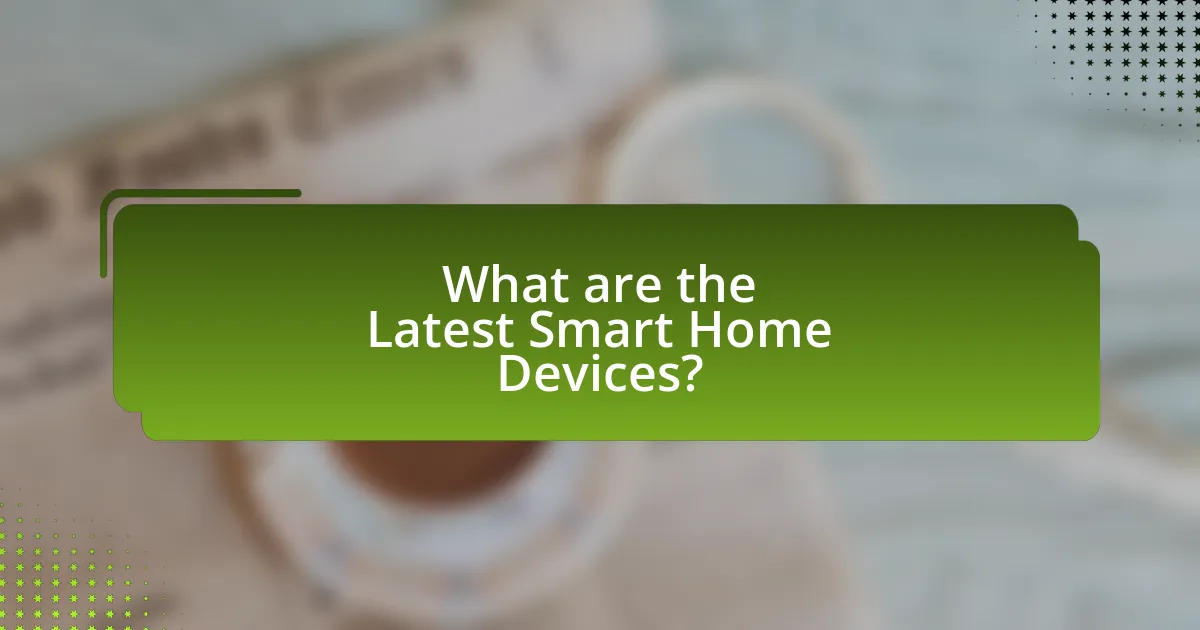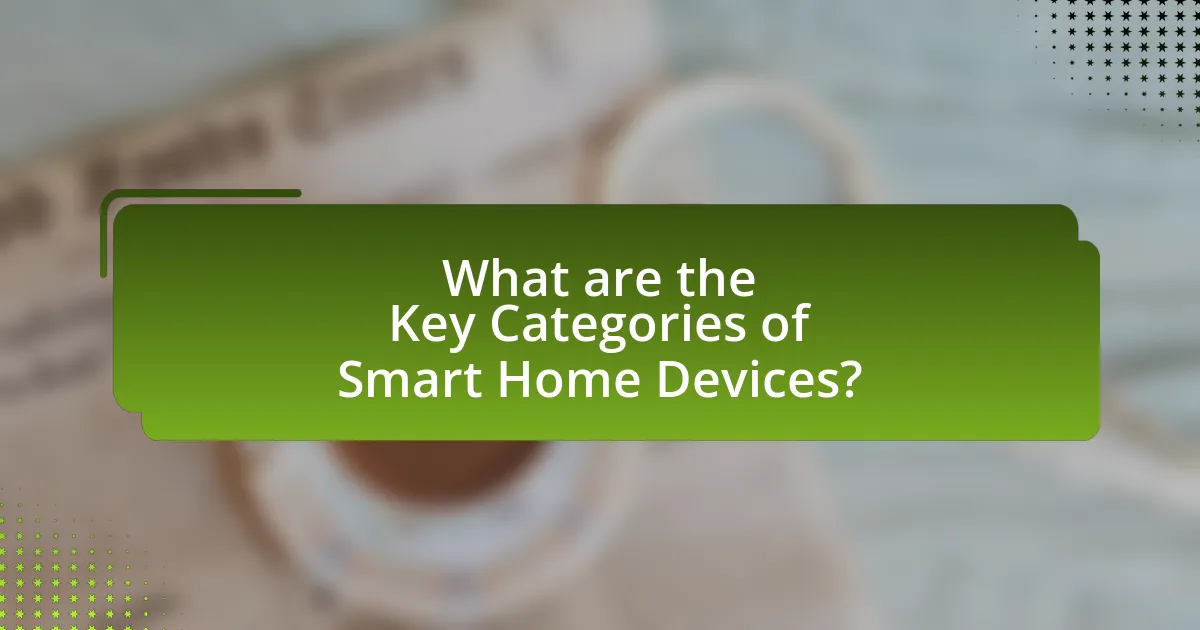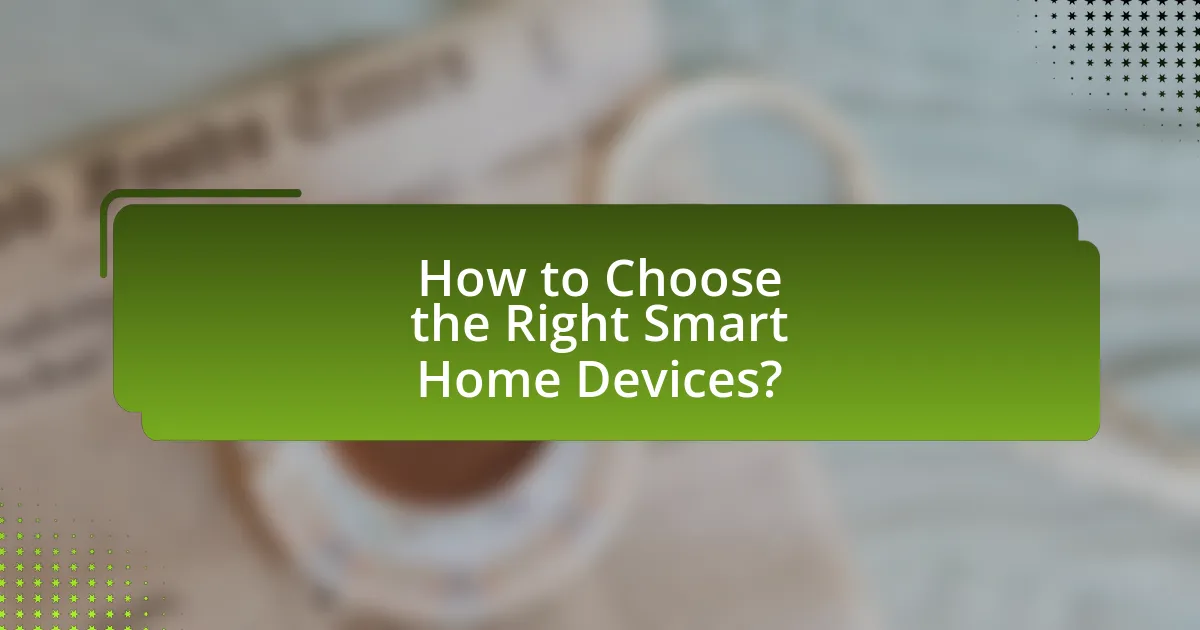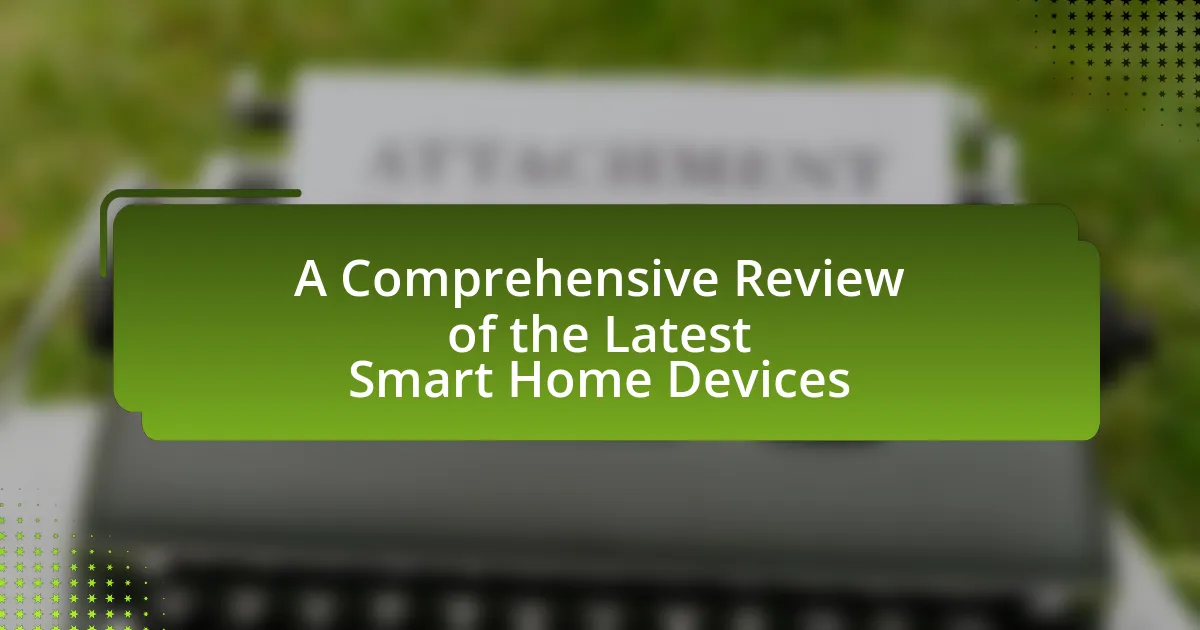The article provides a comprehensive review of the latest smart home devices, highlighting key products such as the Amazon Echo Show 15, Google Nest Hub (2nd Gen), and Philips Hue Smart Bulbs. It explores how these devices enhance daily living through automation, energy efficiency, and security features. The article also discusses the functionalities offered by smart home devices, their integration with existing home systems, and current market trends shaping their development. Additionally, it addresses consumer demands, key categories of devices, and best practices for setup and troubleshooting, ensuring readers gain a thorough understanding of the evolving smart home landscape.

What are the Latest Smart Home Devices?
The latest smart home devices include the Amazon Echo Show 15, Google Nest Hub (2nd Gen), and Philips Hue White and Color Ambiance Smart Bulbs. The Amazon Echo Show 15 features a 15.6-inch display and integrates with various smart home systems, allowing users to control devices, view security cameras, and access entertainment. The Google Nest Hub (2nd Gen) offers a 7-inch display with improved audio quality and sleep tracking capabilities, enhancing user interaction with smart home ecosystems. Philips Hue Smart Bulbs provide customizable lighting options and can be controlled via voice commands or mobile apps, making them versatile for different settings. These devices reflect the ongoing advancements in smart home technology, focusing on user convenience and integration.
How do Smart Home Devices enhance daily living?
Smart home devices enhance daily living by automating tasks, improving energy efficiency, and increasing security. Automation allows users to control lighting, temperature, and appliances remotely, which simplifies daily routines and saves time. For instance, a study by the Consumer Technology Association found that 70% of smart home device users reported increased convenience in their daily lives. Additionally, smart devices can optimize energy usage, leading to cost savings; the U.S. Department of Energy states that smart thermostats can reduce heating and cooling costs by 10-30%. Enhanced security features, such as smart locks and surveillance cameras, provide peace of mind, with a report from Statista indicating that 60% of smart home users feel safer in their homes.
What functionalities do these devices offer?
Smart home devices offer functionalities such as remote control of home appliances, automation of daily tasks, energy monitoring, security surveillance, and integration with voice assistants. For instance, smart thermostats can learn user preferences to optimize heating and cooling, while smart security cameras provide real-time monitoring and alerts. According to a report by Statista, the global smart home market is projected to reach $174 billion by 2025, highlighting the increasing adoption of these devices for enhanced convenience and efficiency in home management.
How do Smart Home Devices integrate with existing home systems?
Smart home devices integrate with existing home systems through protocols such as Wi-Fi, Zigbee, and Z-Wave, enabling seamless communication and control. These devices often connect to a central hub or directly to a home network, allowing users to manage lighting, security, heating, and appliances from a single interface. For instance, smart thermostats can adjust temperature settings based on data from existing HVAC systems, while smart lights can be programmed to work with traditional switches. This interoperability enhances user convenience and energy efficiency, as evidenced by a study from the Consumer Technology Association, which found that 70% of smart home device owners reported improved home management.
What trends are shaping the Smart Home Device market?
The Smart Home Device market is being shaped by trends such as increased integration of artificial intelligence, growing consumer demand for energy efficiency, and the rise of voice-activated technology. Artificial intelligence enhances device functionality, allowing for personalized user experiences and automation of tasks. The demand for energy-efficient devices is driven by consumer awareness of sustainability and cost savings, with the global smart home market projected to reach $135.3 billion by 2025, according to a report by MarketsandMarkets. Additionally, voice-activated technology, exemplified by devices like Amazon Echo and Google Home, is becoming a standard feature, facilitating seamless control of various smart home devices.
How is technology evolving in Smart Home Devices?
Technology in smart home devices is evolving through advancements in artificial intelligence, interoperability, and energy efficiency. These devices are increasingly utilizing AI to enhance user experience, enabling features like voice recognition and predictive analytics for personalized automation. Interoperability is improving as manufacturers adopt common standards, allowing devices from different brands to communicate seamlessly, which enhances user convenience and system integration. Additionally, energy-efficient technologies are being integrated, such as smart thermostats and lighting systems that optimize energy consumption based on user habits and preferences, contributing to sustainability efforts. These trends are supported by market research indicating that the global smart home market is projected to grow significantly, reaching over $174 billion by 2025, reflecting the rapid adoption and innovation in this sector.
What consumer demands are influencing new Smart Home Devices?
Consumer demands influencing new Smart Home Devices include the desire for enhanced convenience, energy efficiency, and improved security. Consumers increasingly seek devices that simplify daily tasks, such as voice-activated assistants and automated lighting systems, which streamline home management. Additionally, the push for energy-efficient solutions drives demand for smart thermostats and appliances that reduce energy consumption, aligning with sustainability goals. Security concerns also shape consumer preferences, leading to a rise in demand for smart cameras and alarm systems that offer remote monitoring capabilities. According to a report by Statista, the global smart home market is projected to reach $174 billion by 2025, highlighting the significant impact of these consumer demands on the development of new devices.

What are the Key Categories of Smart Home Devices?
The key categories of smart home devices include security systems, lighting controls, thermostats, appliances, and entertainment systems. Security systems encompass smart cameras, doorbells, and alarms that enhance home safety. Lighting controls allow users to manage lighting remotely or through automation, improving energy efficiency. Smart thermostats enable precise temperature control and energy savings by learning user preferences. Smart appliances, such as refrigerators and washing machines, offer connectivity for convenience and efficiency. Finally, entertainment systems integrate smart TVs and speakers for enhanced media experiences. These categories collectively represent the diverse functionalities that smart home devices provide, contributing to increased convenience, security, and energy efficiency in modern living environments.
What types of Smart Home Devices are available?
Smart home devices are categorized into several types, including smart speakers, smart lighting, smart thermostats, smart security systems, smart appliances, and smart home hubs. Smart speakers, such as Amazon Echo and Google Nest, enable voice control and integration with other devices. Smart lighting systems, like Philips Hue, allow users to control lighting remotely and set schedules. Smart thermostats, such as the Nest Learning Thermostat, optimize energy usage by learning user preferences. Smart security systems, including Ring and Arlo, provide surveillance and monitoring capabilities. Smart appliances, like smart refrigerators and ovens, enhance convenience and efficiency in daily tasks. Smart home hubs, such as Samsung SmartThings, serve as central control points for managing various smart devices. These categories reflect the diverse functionalities and applications of smart home technology in modern households.
How do Smart Speakers differ from Smart Displays?
Smart speakers primarily focus on audio output and voice interaction, while smart displays incorporate visual interfaces alongside audio capabilities. Smart speakers, such as Amazon Echo and Google Nest Audio, are designed for tasks like playing music, answering questions, and controlling smart home devices through voice commands. In contrast, smart displays, like the Amazon Echo Show and Google Nest Hub, provide visual feedback, allowing users to view videos, photos, and information, enhancing the interaction experience. The key difference lies in the presence of a screen in smart displays, which enables a broader range of functionalities compared to the audio-centric design of smart speakers.
What role do Smart Thermostats play in energy efficiency?
Smart thermostats significantly enhance energy efficiency by optimizing heating and cooling systems based on user behavior and preferences. These devices utilize algorithms and sensors to learn patterns, allowing them to adjust temperatures automatically, which can lead to energy savings of up to 10-15% on heating and cooling bills, according to the U.S. Department of Energy. By reducing unnecessary energy consumption during periods of inactivity or when occupants are away, smart thermostats contribute to lower overall energy usage and decreased greenhouse gas emissions.
What are the security features of Smart Home Devices?
Smart home devices incorporate several security features to protect user data and privacy. These features include end-to-end encryption, which secures data transmitted between devices and users, making it difficult for unauthorized parties to intercept information. Additionally, many smart home devices utilize two-factor authentication (2FA) to enhance user account security by requiring a second form of verification beyond just a password. Regular firmware updates are also a critical security feature, as they patch vulnerabilities and improve device security over time. Furthermore, some devices offer network segmentation, isolating smart devices from the main home network to reduce the risk of unauthorized access. These security measures are essential for safeguarding personal information and ensuring the integrity of smart home systems.
How do Smart Cameras enhance home security?
Smart cameras enhance home security by providing real-time surveillance and alerts for unusual activities. These devices utilize motion detection technology to monitor specific areas and send instant notifications to homeowners via mobile apps. According to a study by the Security Industry Association, homes equipped with smart cameras experience a 50% reduction in burglary attempts compared to those without such systems. Additionally, many smart cameras offer features like night vision, two-way audio, and cloud storage, allowing users to review footage and communicate with visitors remotely, further increasing the effectiveness of home security measures.
What are the privacy concerns associated with Smart Home Devices?
Smart home devices raise significant privacy concerns primarily due to their ability to collect, store, and transmit personal data. These devices often require access to sensitive information, such as user habits, preferences, and even real-time location data, which can be exploited if not properly secured. For instance, a study by the Electronic Frontier Foundation highlights that many smart home devices lack adequate encryption, making them vulnerable to hacking and unauthorized access. Additionally, data sharing practices among manufacturers can lead to personal information being sold to third parties without user consent, further exacerbating privacy risks.

How to Choose the Right Smart Home Devices?
To choose the right smart home devices, assess your specific needs, compatibility with existing systems, and the reliability of the brand. Identifying your requirements, such as security, energy management, or convenience, helps narrow down options. Compatibility ensures that devices can communicate effectively, often relying on standards like Zigbee or Z-Wave. Brand reliability can be evaluated through customer reviews and industry ratings, with reputable brands often providing better support and updates. According to a 2021 survey by Statista, 45% of smart home device users prioritize compatibility with other devices, highlighting its importance in the selection process.
What factors should be considered when selecting Smart Home Devices?
When selecting Smart Home Devices, compatibility with existing systems is crucial. Devices must seamlessly integrate with your current home automation ecosystem, such as smart hubs or voice assistants, to ensure functionality. Additionally, consider the security features of the devices, as vulnerabilities can expose your home network to risks; for instance, a 2020 study by the Cybersecurity & Infrastructure Security Agency highlighted that 98% of IoT devices have known vulnerabilities. Furthermore, evaluate the ease of use and installation, as user-friendly devices enhance the overall experience. Lastly, assess the manufacturer’s reputation and customer support, as reliable brands often provide better long-term service and updates.
How does compatibility with existing systems affect device choice?
Compatibility with existing systems significantly influences device choice by ensuring seamless integration and functionality within a smart home ecosystem. When devices are compatible with established systems, such as smart hubs or voice assistants, users experience enhanced convenience and efficiency, as these devices can communicate and operate together effectively. For instance, a study by Parks Associates indicates that 70% of consumers prioritize compatibility when selecting smart home devices, highlighting its critical role in consumer decision-making. This preference for compatibility leads to increased user satisfaction and reduces the likelihood of device malfunction or the need for additional configurations.
What budget considerations should be taken into account?
When budgeting for smart home devices, consider the initial purchase cost, installation expenses, ongoing maintenance fees, and potential subscription services. The initial purchase cost varies widely based on the type and brand of devices; for example, smart thermostats can range from $100 to $300. Installation expenses may include professional setup, which can add $50 to $200 depending on complexity. Ongoing maintenance fees, such as software updates or repairs, should also be factored in, as they can accumulate over time. Additionally, many smart devices require subscription services for advanced features, which can cost anywhere from $5 to $30 monthly. These considerations ensure a comprehensive understanding of the total financial commitment involved in adopting smart home technology.
What are the best practices for setting up Smart Home Devices?
The best practices for setting up smart home devices include ensuring a strong and secure Wi-Fi network, using compatible devices, and following manufacturer guidelines for installation. A robust Wi-Fi network is essential because smart devices rely on internet connectivity for functionality; according to a study by the Consumer Technology Association, 70% of smart home device issues stem from connectivity problems. Compatibility among devices is crucial to ensure seamless integration; for instance, devices that support the same communication protocols, such as Zigbee or Z-Wave, work better together. Lastly, adhering to manufacturer instructions during setup minimizes errors and enhances device performance, as improper installation can lead to malfunctions or security vulnerabilities.
How can users ensure optimal performance of their devices?
Users can ensure optimal performance of their devices by regularly updating software and firmware. Keeping software current enhances security and introduces performance improvements, as manufacturers often release updates to fix bugs and optimize functionality. For instance, a study by the Cybersecurity & Infrastructure Security Agency (CISA) indicates that outdated software can lead to vulnerabilities, which can compromise device performance and security. Additionally, users should manage storage by deleting unnecessary files and applications, as devices with low storage can experience slowdowns. Regularly rebooting devices can also help clear temporary files and refresh system processes, contributing to better performance.
What common mistakes should be avoided during setup?
Common mistakes to avoid during setup of smart home devices include neglecting to read the user manual, failing to ensure compatibility with existing systems, and overlooking network security settings. Reading the user manual is crucial as it provides specific instructions and troubleshooting tips tailored to the device. Ensuring compatibility is essential because many smart devices require specific ecosystems or protocols to function correctly, such as Zigbee or Z-Wave. Additionally, overlooking network security settings can expose devices to vulnerabilities; for instance, not changing default passwords can lead to unauthorized access. These mistakes can lead to poor performance, security risks, and ultimately, user frustration.
What troubleshooting tips are available for Smart Home Devices?
To troubleshoot Smart Home Devices, first ensure that the device is powered on and connected to the Wi-Fi network. If the device is unresponsive, try restarting it by unplugging it for a few seconds and then plugging it back in. Additionally, check for software updates, as outdated firmware can cause functionality issues. If connectivity problems persist, verify that the router is functioning properly and that the device is within range of the Wi-Fi signal. Resetting the device to factory settings can also resolve persistent issues. These steps are commonly recommended by manufacturers and tech support resources to enhance device performance and connectivity.
How can connectivity issues be resolved?
Connectivity issues can be resolved by ensuring that devices are within range of the router, updating firmware, and checking for interference from other electronic devices. Maintaining a strong Wi-Fi signal is crucial; for instance, placing the router in a central location can enhance coverage. Regularly updating the firmware of smart home devices can fix bugs and improve performance, as manufacturers often release updates to address connectivity problems. Additionally, minimizing interference from microwaves, cordless phones, and other wireless devices can significantly improve connectivity, as these can disrupt Wi-Fi signals.
What steps should be taken for device malfunctions?
To address device malfunctions, first, power cycle the device by turning it off and then back on, which often resolves temporary issues. If the problem persists, check for software updates, as manufacturers frequently release patches that fix bugs. Additionally, inspect the device for any physical damage or loose connections, as these can lead to malfunctions. If these steps do not resolve the issue, consult the user manual for troubleshooting tips specific to the device model. Finally, if the device remains non-functional, contact customer support for further assistance or consider warranty options for repair or replacement.



